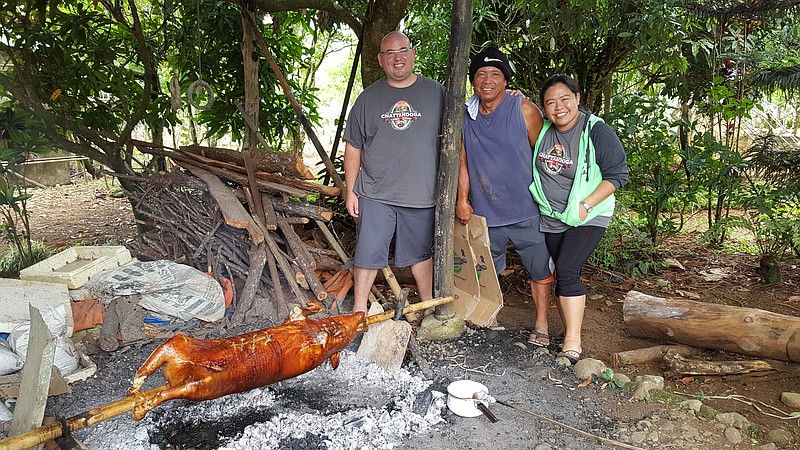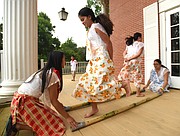If you go
› What: Filipino-American Association of Greater Chattanooga lechon feast › Where: Harrison Bay State Park Pavilion, 8411 Harrison Bay State Park Road › When: 11 a.m. Sunday, Aug. 7 › Admission: $5 adults who bring a potluck dish and $3 for their children; $10 for adults who prefer not to bring a dish and $5 for their children; kids under age 5 are free. › Information: Call Elvie Smith at 423-800-2217
Filipino Dance
What’s a Filipino feast without music and dancing? Well, not really a feast.“But it can be hard to coax men onto the dance floor, which I guess is what women say in every culture,” Elvie Smith, president of the Filipino-American Association of Greater Chattanooga, says, with a laugh.The roots of Filipino dance began when Spanish conquistadors punished Filipino farm workers who weren’t picking crops fast enough to suit the bosses. Punishment came in the form of making workers hop back and forth between heavy sticks laying on the ground that the foremen smashed together swiftly around the workers’ feet and ankles. Filipinos are so resilient and spirited, they took the punishment and turned it into a dance that showcases agility and grace.On a recent July evening in Heritage Park, a rainstorm forces the association’s dance troupe under the huge, sheltering roof of the Henshell mansion. Spilling from a boombox is music that’s lighthearted with silvery guitars accented by chiming percussion. The infectious beat is punctuated by crashing thunder punctuates as rain falls in heavy sheets. The dance is called Tinikling, a name that seems to fit the music’s bell-like quality.Juliana Gonzalez and Ally Pendon kneel down on the porch, then pick up two long, heavy sticks, about 3 inches in diameter, and begin banging them together. Barefooted Brienn Ayerdi leaps between the sticks and back out, his feet darting between them then away before they can smack his ankles. He never even breaks a sweat. Then girls come over and dance in and out of the crashing sticks until the dance is done.“Wow, you get an upper-body workout working the sticks,” Gonzalez smiles, “but it’s easier than the dancing. When I was first learning how to dance, I wasn’t quick enough on one jump and got my toe and heel smacked. But nothing was broken. We don’t hit the sticks hard enough to break any bones.”She’s wearing a crisp, lace jacket over a long red-plaid skirt; Ayerdi wears a red kerchief, loose white shirt and tan cargo pants. Both outfits are national costumes of the Philipines and still worn at special celebrations. Tinikling is not the only Filipino folk dance; the nation even has its own version of the tango.“We actually have a lot of dances that are as passionate as the tango,” Smith says.
The first wave of Chattanooga's Filipino immigrants were nursing students who came here back in the 1970s to attend school and fill America's urgent need for nurses at the time. Filipino nurses still come here to study but so do Filipino engineers, teachers and other professionals.
These days, there is a big enough Filipino community in town to host a festival or a pig roast and also to form the 300-member Filipino-American Association of Greater Chattanooga, a number that doesn't include spouses, children and friends who want to attend the colorful and tasty events hosted by the association.
And now local Filipino-Americans want to share their vibrant culture through three passions Southerners and Filipinos share - music, dancing and pork. Yes, pork.
The most glorious Filipino pork dish is the "lechon de leche" - a pig stuffed full of lemongrass and whole onions then roasted on a spit over coals for about four hours. The pig is constantly bathed in coconut or vegetable oil mixed with salt until its skin turns the color of copper and crackles when the cook touches it.
"We're hoping any Chattanoogan who wants to will come to our lechon party in August. There are absolutely no restrictions on who can join," says Association President Elvie Smith. "The admission to the party is just $5 if you bring a potluck dish. And it doesn't have to be fancy, just something you enjoy."
"Lechon" is Spanish for piglet, but the pig can be enormous if the party is big. And to be Filipino lechon, the animal must be a free-range pig whose farmer allows his pigs to run through meadows and forests, munching on mushrooms, root veggies, fallen fruit, grass, cabbage, fruit, nuts and table scraps.
"Leche" is Spanish for milk, and the classic Filipino leche is a pig so young it's still feeding on mother's milk. A pig that spends its life on a factory farm, barely able to move inside its stall and eating manufactured feed is too sad to be suitable for lechon, says association member Annalyn Jones. Born and raised in the Philippines, she believes you can almost taste the factory pig's despair.
"You have to use a free-range pig to be the lechon; the taste is completely different from a pig who spends his life in a factory farm," Annalyn says.
The Filipino-American Association of Greater Chattanooga usually buys a free-range pig from one of the family farms in the counties around Chattanooga. Sometimes a sponsor donates one.
Annalyn, husband Jason and stepson Tyler, who attends Heritage High School in Ringgold, Ga., all visited the Philippines - where some of Annalyn's family still lives - in July and roasted their own lechon.
"Lechon tastes like deliciousness," Jason agrees.
Jason and Annalyn lived for months on her parents' farm in 2008, so he learned a lot about Filipino culture.
"I loved it because it was such an adventure," Jason says. "It was in the middle islands so it was very peaceful, very green and beautiful. I learned to harvest crops with a machete.
"Filipino cuisine is pretty diverse and a lot of it is suited to American tastes."
Contact Lynda Edwards at 423-757-6391 or ledwards@timesfreepress.com.

